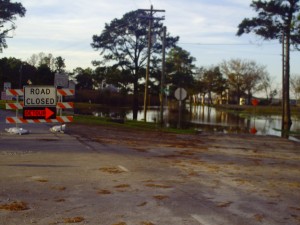Exactly one year ago today, we were preparing for the arrival of our MV-1. Due to the holiday travel, it did not arrive until January 5th. We felt giddy in making lists of we would need for our new vehicle. By mid-month, three snowopolis storms froze the cities of the South, particularly Atlanta and Raleigh. This was not the first time we had conversations about how emergency preparedness related to people with disabilities.
When Katrina roared through Tuscaloosa, Alabama, it was still a Category One. Barton and I huddled in our tiny bathroom with tornado sirens blaring outside. However, over the radio, the Emergency Management System had lost power, so we did not know why the sirens where going off or how long to stay in a safe space. Barton’s wheelchair would not fit through the bathroom doors, so I huddled the tub with our puppy, while Barton sat in his motor wheelchair in the doorway.
During the night, while we waited out the storm, we had our first real conversations about emergency preparedness. We talked through every scenario we could think of, and how our actions may be different because he uses a power wheelchair. Of course, the idea behind emergency preparedness is to have these conversations before the emergency.
So it was natural, the weekend we waited for our new accessible MV-1 to be delivered, that we discuss different emergency situations on the road, and began to gather supplies we would need, and where we would keep them in our vehicle.
Here is what every person driving on the road needs to know about emergency preparedness.
1. Every emergency situation is different.
Consider different ways that you could be in an emergency situation. It could be as simple as a blown-out tire or as complicated as an accident, being stuck in a snowstorm low on gas, or being evacuated because of a natural disaster. What supplies you need or action to take will be dictated by where you are and what is happened around you. While we can’t predict everything that will happen in our lives, looking at short-term and long-term emergency situations will help you prepare.
2. Communication is key.
Barton has a thick accent due to Cerebral Palsy, and right or wrong, people still have stereotypes about people with disabilities. How you communicate with others what you need becomes vital, especially in situations that are chaotic.
Who else may drive your vehicle? Creating a folder with current insurance information, emergency contacts, or list of supplies can be helpful for direct care personnel or caretakers who are also drivers.
Supplies may include: folder with insurance and registration information, pre-paid mobile phone, ICE (In Case of Emergency) specialized notes on I-phones or I-pads, whistle, air horn, visual aide cards, glow sticks, a quiet seat or corner space (helpful for those with sensory sensitivities to have a calm environment).
3. Evacuation from Your Vehicle.
What might you need to get out of your vehicle and find a safe space? Supplies are only as good as being able to access them, so think about where you will keep these supplies so you have access to them.
Supplies may include: Seatbelt cutter, window breaker, portable ramp, float vest, rope, maps.
Questions to ask: If you have a motorized ramp, is there manual deployment of the ramp? If a roadway is impassible because of flooding, do you have an alternative route? Many accessible vehicles are lower to the ground. If an accessible vehicle stops in the middle of flooded water or other emergency, what is the best way for you to evacuate?
4. Medical or durable medical equipment.
Many people with disabilities have specialized equipment. Equipment may come in the form of assistive devices such as walkers or wheelchairs, medical supplies, and medication.
Vehicles have limited space and each person must decide how much supplies/personal information to keep in their vehicle as a back-up.
Some items to consider are: what medical equipment you may need to take with you in an emergency situation, and how long with battery power last (if it runs by motors). Do you have back-up medication, access to doctor and insurance #s, a location or evacuation center that knows about specialized care that you may need?
Supplies may include: back-up power wheelchair charger, electrical or duct tape, wheelchair repair kit, medical kit, first aide kit, back-up medication.
5. Other Living Emergency Supplies.
When a storm hits, everyone seems to hoard bread and milk at the store. However, are these really the supplies you need? If the power goes out, milk may sour. And you may be wishing for some other food snacks instead.
Maybe you don’t keep all of these supplies in your vehicle. Or you store supplies in different places. Whether it’s in your house or your vehicle, do you have what you need for 3-5 days of living? Or, do you have what you need in inclement weather if you get stuck on the road to keep warm and dry.
Supplies may include: extra pair of clothes and shoes, first aide kit, water, beef jerky, granola bars or other snacks, blanket, hand or feet warmers, poncho, fire-starter, air- compressor, flashlight, matches, multi-utility tool, scissors, marker/chalk, pet food (if you have a pet), emergency fund.
6. Vehicle Care and Sustainability.
Some emergency situations are avoidable, like running out of gas. We know we should have stopped, but we were in a hurry, and now we find ourselves sitting on the side of the road. It happens to all of us!
Vehicle care may include: filling gas tanks and checking fluids, regular oil changes, regular maintenance. It may also be having a security system or a reminder to lock your doors or having a back-up camera installed for vision.
Additional supplies you may need: jumper cables, oil, tire gauge or fix-a-flat.
7. Plan, and then throw out your plan.
Life never happens in the way we expect it to play out. Gather supplies and create emergency plans, and then go with the flow. Try to stay calm, and if you find yourself in a stressful situation, remember to breathe.
We have already used one of our emergency tools. One afternoon, Barton’s wheelchair was still on, and the joystick got trapped underneath the shoulder strap seat belt, propelling the wheelchair forward. Barton couldn’t free the joystick, and it became difficult for him to breathe. Using the seatbelt cutter, we were able to easily free Barton out of this precarious position.
Creating an emergency plan doesn’t happen overnight, and it becomes an on-going conversation that changes with your life. Invite your whole family into the discussion, so that each member knows what to do!
Conversations are not just about preparing for the worst; it’s about having the confidence you need to be independent on the road, so you can be poised for your next adventure!
Related:
Social Media in Emergency Recovery and Natural Disasters
WBST Interview- Launch of the MV-1
A Trip of a Lifetime: Speaking at the MV-1 Event
In the Wake of Katrina’s Path


